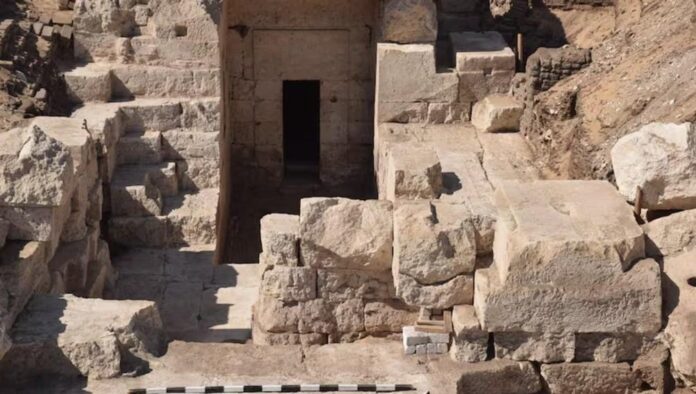A full pylon from a Ptolemaic temple named Batlmy has been discovered on the western side of the main temple in Sohag, a city rich with history on the west bank of the Nile. The excavations were taking place in the ancient city of Athribis, a significant site for the worship of the god Min-Re, his wife Repyt, and their son Kolanthes.
This find is truly unique and is causing a lot of excitement in the field of archaeology.
A Complete Front: Understanding the Inscriptions
The Egyptian German archaeological mission, led by Dr. Mohamed Ismail Khaled, uncovered the pylon. This discovery opens up opportunities for further exploration at the temple site, where a large portion is still underground, as described in a press release.
“The front of the pylon has been completely revealed, measuring 51 meters (167.323 ft) wide, with two towers each 24 meters (78.74 ft) wide and separated by the entrance gate,” said Dr. Ismail Khaled in the press release.
The Ptolemaic era in Egypt, spanning from 305-30 BC, combined Greek and Egyptian influences under the rule of Ptolemy I Soter, a general of Alexander the Great. The rulers of this dynasty embraced local traditions while introducing Greek language, art, and culture.
During the cleaning of the entrance gate, hieroglyphic texts were found on the exterior, and the interior walls also had inscriptions. Depictions of the emperor meeting Repyt, the temple’s patron goddess, and her son were also discovered.
Discovery of hieroglyphic texts and scenes depicting the king receiving Repyt. (Supreme Council of Antiquities)
“The cartouches found at the entrance and on the interior sides indicate that this gate dates back to the reign of King Ptolemy VIII, possibly the temple’s founder,” explained Mohamed Abdel Badie, head of the Egyptian side of the mission. The texts may also contain the name of Queen Cleopatra III.
Ptolemy VIII reigned from 170 BC to 116 BC and was known for his political acumen, as well as cruelty, obesity, and decadence, according to The Heritage Daily. Details about his rule are scarce, making this find valuable.
The southern chamber of the temple was previously unearthed by a British expedition, noted Dr. Christian Leitz from the German team. This chamber’s entrance is adorned with hieroglyphs, featuring scenes of Repyt and Min, surrounded by celestial deities, likely used for measuring time during the night.

View of the temple complex in Sohag being excavated. (Supreme Council of Antiquities)
Dr. Marcus Muller, the site director from the German team, mentioned finding a previously unknown room above a staircase, as reported by The National News. The room likely had a smaller entrance on the outside with steps leading to an upper floor that may have been destroyed by 752 AD.
Egyptian German Collaboration: Unveiling Numerous Discoveries
The joint Egyptian German mission has been active in Athribis for over ten years, fully excavating the main Athribis Temple and discovering over 30,000 ostraca with various texts. Their upcoming excavation season aims to reveal the full extent of the temple, with support from the Supreme Council of Antiquities through the University of Tübingen’s Athribis Project. This ancient structure holds many secrets waiting to be uncovered, and the mission is committed to revealing them all.
Top image: Egyptian-German archaeologists uncover a remarkable Ptolemaic temple in southern Egypt from the Ptolemaic era. Source: Supreme Council of Antiquities
By Sahir Pandey




